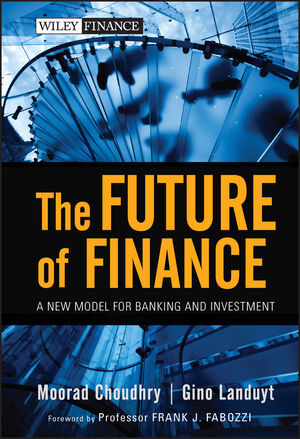The Future of Finance: A New Model for Banking and InvestmentISBN: 978-0-470-57229-0
Hardcover
224 pages
November 2010
 |
||||||
Foreword xi
Preface xiii
Introduction xix
Market Instability xx
Derivatives and Mathematical Modeling xxi
Senior Management and Staying in the Game xxiii
Macroprudential Financial Regulation and Cycle-Proof Regulation xxiii
The Way Forward xxv
Conclusion xxvi
Part One A Review of the Financial Crash 1
Chapter 1 Globalization, Emerging Markets, and the Savings Glut 3
Globalization 3
A Series of Emerging-Market Crises 5
Low-Yield Environment Due to New Players in the Financial Markets 8
Artificially Low Exchange Rates 15
Recommendations and Solutions for Global Imbalances 16
Chapter 2 The Rise of Derivatives and Systemic Risk 22
Systemic Risk 23
Derivative Market Systemic Risk: Solutions for Improvement 30
Chapter 3 The Too-Big-to-Fail Bank, Moral Hazard, and Macroprudential Regulation 37
Banks and Moral Hazard 37
Addressing Too-Big-to-Fail: Mitigating Moral Hazard Risk 42
Macroprudential Regulation: Regulating Bank Systemic Risk 53
Conclusion 58
Chapter 4 Corporate Governance and Remuneration in the Banking Industry 60
Bonuses and a Moral Dilemma 60
A Distorted Remuneration Model 61
Unsuitable Personal Behavior 64
Conclusion 65
Chapter 5 Bank Capital Safeguards: Additional Capital Buffers and Reverse Convertibles 67
Capital Issues in a Bear Market 67
Looking for New Capital Instruments 69
Chapter 6 Economic Theories under Attack 76
A Belief in Free and Self-Adjusting Markets 76
Modigliani and Miller 85
Markowitz and Diversification Tested 85
Minsky Once Again 88
Lessons to Be Learned by Central Banks 89
Conclusion 92
Part Two New Models for Banking and Investment 93
Chapter 7 Long-Term Sustainable Investment Guidelines 95
The Investment Landscape after the Crisis 95
Government Debt and Demographics 97
A New Economic Environment 103
The Inflation Dragon 105
Currencies and a Changing Geopolitical Landscape 115
Exchange-Traded Funds: A Flexible Asset Class 118
Conclusion 121
Chapter 8 Bank Asset-Liability and Liquidity Risk Management 123
Basic Concepts of Bank Asset-Liability Management 123
Asset and Liability Management: The ALCO 134
ALCO Reporting 137
Principles of Banking Liquidity Risk Management 142
Measuring Bank Liquidity Risk: Key Metrics 145
Internal Funding Rate Policy 151
Conclusion 157
Chapter 9 A Sustainable Bank Business Model: Capital, Liquidity, and Leverage 158
The New Bank Business Model 158
Corporate Governance 167
Liquidity Risk Management 168
The Liquid Asset Buffer 175
Conclusion 177
Notes 179
References 187
About the Authors 189
Index 191



